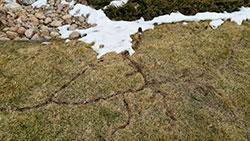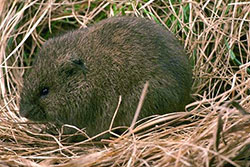Adapted by Alison O’Connor, Larimer County Extension, from the CO-Horts blog originally authored by Tony Koski, CSU Extension Turf Specialist

There are eight species of voles that live throughout Colorado; the one most likely to be found in urban landscapes is the meadow vole (Microtus pennsylvanicus) – often called the field or meadow mouse. Textbook signs of vole activity on turf areas include tunneling and raised soil in the lawn. Areas that have prolonged snow cover provide ideal conditions for these small rodents. While active year-round, vole activity is more apparent in winter and spring when turf is not actively growing. Less obvious is the damage they may be causing to woody plants in the landscape.
Voles are strictly vegetarian. In Colorado landscapes their favorite food sources include turfgrass and the stems and bark of shrubs and trees. They can also be a nuisance in vegetable gardens, where they will eat seedling plants, as well as potatoes, carrots and other root veggies (voles are excellent burrowers). They will eat iris, flower bulbs, and some perennials (hostas are a favorite) in flowerbeds. When vole pressure is heavy, both newly planted and older, established trees can be killed by feeding that girdles the trunk. Along the Front Range, junipers frequently suffer from vole damage – probably because they provide both perfect cover and a ready source of food throughout the year.

Vole populations – and thus the damage caused by them – are very cyclical, with peak numbers occurring every 3-4 years, followed by years where they are hardly noticed. Turf damage is more severe in years where snow cover persists for more than a few weeks – shaded landscapes, the north side of structures, or where snow is piled during removal. Mountain golf courses often suffer severe vole damage on an annual basis because snow cover lasts so long. The above-ground trails seen in lawns will connect to a hole which is the entrance to a maze of underground tunnels.
Voles are more common in landscapes that border natural areas or greenbelts where grass is tall and infrequently mowed. Especially attractive are shrub and flower beds which are covered with landscape fabric. Discourage voles by eliminating places for them to hide and reproduce (they breed throughout the year, having as many as 5 litters of 3-5 young each time!). Avoid the use of landscape fabric and pull mulch away from the bases of trees and shrubs. Mow tall grass in “native” or natural areas adjacent to lawn areas in the fall after the grass has stopped growing. Woody plants and treasured perennials can be protected by the use of wire mesh screening to prevent feeding.
Research with voles suggests that repellents are largely ineffective because they don’t last long and simply cause the voles to move to another area of your landscape. While there are poisonous baits (the anticoagulants used for mouse and rat control in structures) that can be effective, you have to be vigilant in providing the bait and have to be concerned about children, pets and other non-target wildlife when using them.
Trapping can be highly effective for eliminating (or at least reducing) vole populations in the home landscape. An unbaited mousetrap, placed on vole trails and/or near their holes at the end of the trails, can be used with great success. Drill a hole in the center of the trap so that it can be anchored in the ground with a large nail, to keep it in place. Look for signs of activity on the trails and at the burrow openings—bits of chewed grass clippings and freshly deposited, tiny pellets of feces. Set the traps where the voles are most likely to cross the trigger. Because it’s difficult to tell from which direction voles will be traveling on their trails, a good strategy is to place two traps end to end (with the triggers on opposite ends) directly within the vole trail.
Cover the traps with a length of gutter or a tunnel fashioned from a half-gallon, cardboard milk carton. The tunnel will keep nosy dogs and cats away from traps and can “guide” the voles into the traps. If you do choose to trap voles, take special precaution with handling and disposing of the vole cadavers. Recent research has shown that voles can be heavily infected with the bacterium that causes tularemia in humans and other mammals.
A good source of more detailed information on voles can be found at: http://extension.colostate.edu/topic-areas/natural-resources/managing-voles-in-colorado-6-507/



